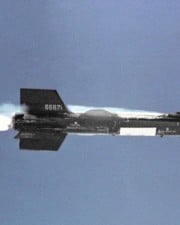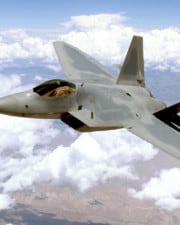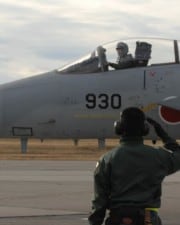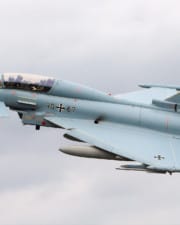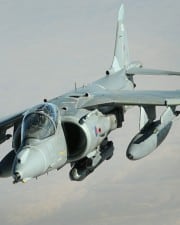If there is one name that’s been dominating military aircraft development the last few decades, it is Lockheed Martin. Surprisingly though, the list of fighter jets made by the company is not all that long. Only 9 aircraft made it onto this list.
Lockheed Martin is an aerospace, military support, security, and advanced technologies company located in Bethesda, Maryland. It is primarily engaged in the studies, design, evolution, construction, production, innovation, and maintenance of advanced technology systems, products, and services.
The United States’ dominance in the world couldn’t have been the same without the innovating technologies realized by Lockheed Martin. The evolution of technologically advanced aircraft crucial to the national defense, and introducing the stealth technology that has changed the perspective of American war fighting capabilities, Lockheed Martin truly has brought military aviation to new levels.
Innovation, performance, and purpose- these were the keys to the advancement of Lockheed Martin. The Lockheed Martin fighter jets stood out since the early years up to this advancing generation.
Lockheed Martin’s air superiority over the battlefield is obtained through nonstop studies, experimentation, and testing to produce high-performance, technologically-advanced, and top of the class fighter jets.
And as for the Skunk Works division which gave birth to several fighter aircraft, the company’s mission stayed much the same: build the world’s most experimental aircraft and breakthrough technologies in abject secrecy at a pace impossible to rival.
Listed below are nine of the best Lockheed Martin fighter jets from history up to this age.
1. Lockheed P-38 Lightning
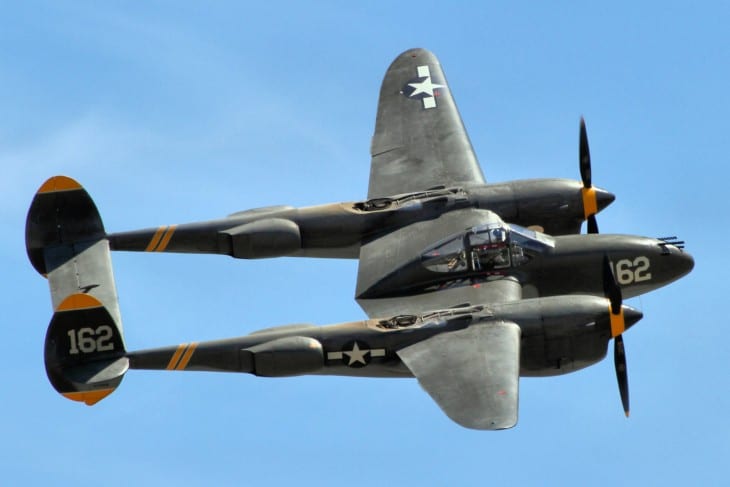
Okay, it’s not a jet, but we still felt the P-38 deserves to be on this list as one of the most successful Lockheed Martin Fighter Planes to have served. The P-38 Lightning is a high-speed, high-altitude fighter bomber made during the Second World War for the United States Army Air Corps. The prototype conducted its maiden flight on January 27, 1939, by its test pilot, Benjamin Kelsey. The
P-38 was used in several aerial warfares as a fighter bomber, night fighter, and escort fighter engineered with a drop tank system for longer range. P-38s successfully downed many German Fighters in WW2, earning it its nickname, the Fork-tailed devil.
Lockheed Martin secretly incorporated several advanced features of its time including a notable structural revolution where the aircraft’s aluminum skin panel was joggled, fitted and flush-riveted, a modification that was not required in the military specification, yet one that would yield reduced aerodynamic drag and provide higher strength with lower mass. Also atypical for a fighter aircraft of its time was the turbo-superchargers that produced noiseless operation and better performance on high-altitudes.
The P-38 can climb up to 3,300 feet per minute and has been recorded as the first military aircraft to reach and exceed 400 mph in the world. It can fly 100 mph faster compared to any fighter in its time and can carry a greater payload with a range of 1,000 nautical miles.
2. Lockheed P-80 Shooting Star
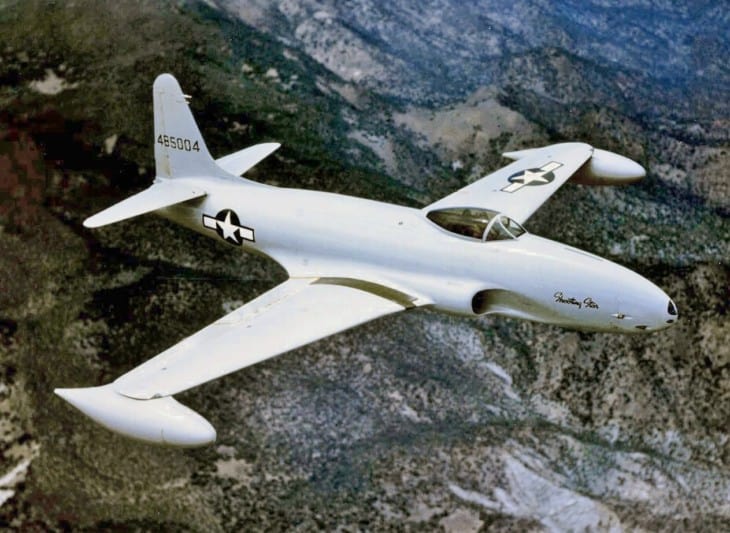
The P-80 Shooting Star was the first combat-ready jet fighter utilized by the United States Army Air Forces. Developed in 1943 and conducted first flight on January 8, 1944, it was the first American turbojet-powered jet fighter to win the first all-jet combat in the world.
The aircraft was named as the “Shooting Star” because of its unmatched speed, with several modified models capable of transcending 600 mph. The fuselage which was built in a bullet-shaped configuration, together with flush rivets and its polished skin gave a domineering impression as an attack aircraft, armed with six M3 Browning machine guns, eight HVAR unguided rockets, and two 1,000-lb bombs.
The P-80 Shooting Star has a typical range of 717 nautical miles and can fly up to 46,800 feet. It can climb at a rate of 6,870 feet per minute.
3. Lockheed F-94 Starfire

The F-94 Starfire was a first-generation jet fighter and an all-weather interceptor developed for the United States Air Force. It was the first United States fighter jet to have an afterburner and was the first jet-powered all-weather interceptor to engage in combat in the time of the Korean War in 1953. The aircraft took its first flight on April 16, 1949.
The Starfire adapted some of the looks of the T-33 Shooting Star including the tail, wing, and landing gear. Additional features were added such as the redesigned fuselage and a lengthened nose area with guns. It is also equipped with Hughes E-1 automatic fire control system, AN/APG-33 radar, and a Sperry A-1C computing gunsight for terminal phases of interception.
The aircraft has a maximum speed of 640 mph and a typical range of 700 nautical miles. It has a service ceiling of 51,400 feet and a climb rate of 7,980 feet per minute.
4. Lockheed F-104 Starfighter

The F-104 Starfighter is a supersonic interceptor aircraft that has been extensively used as a fighter-bomber during the Cold War. It was developed in the 1950s as a day fighter before it turned into an all-weather fighter in the late 1960s. Built initially for the United States Air Force, but was later adopted by NATO and several other countries. The Starfighter took to the skies for the first time on March 4, 1954.
The sleek, yet durable, F-104 Starfighter was the perfect NATO warplane. It was the first fighter aircraft that can sustain Mach 2 flight, which set numerous records in the world for its altitude and airspeed capabilities. It was armed with an M61A1 6-barreled Gatling cannon, four AIM-9 Sidewinder missiles, and other bombs and rockets.
The F-104 Starfighter has a maximum speed of 1,528 mph and was strong enough to weather any storm that brewed before it. It has a combat range of 360 nautical miles and has a service ceiling of 50,000 feet.
5. Lockheed Martin F-16 Fighting Falcon

The F-16 Fighting Falcon is a supersonic, multirole, air superiority fighter originally built by General Dynamics before it was acquired by Lockheed Martin in 1993. It was initially designed as an air superiority day fighter then later developed into an all-weather multirole combat aircraft. Since its maiden flight in December 1976, this supermaneuverable air-to-air combat and air-to-surface attack aircraft have proven its versatility and high-performance during missions at a fairly low-cost.
This lightweight fourth-generation fighter features a frameless bubble canopy for greater visibility, sidestick controller for easy maneuvering, a 30-degrees reclined ejection seat to decrease the effect of gravitational forces on the pilot, and the first use of a fly-by-wire system for agility and relaxed stability. It is loaded with an internal M61 Vulcan six-barrel rotary cannon, a variety of air-to-air, air-to-surface and anti-ship missiles, rockets, and bombs.
The Fighting Falcon has a maximum speed of 921 mph at sea level and can fly up to 50,000 feet. It has a combat range of 295 nautical miles on a hi-lo-hi mission with four 1,000 lbs bombs.
6. Lockheed F-117 Nighthawk

The F-117 Nighthawk is a twin-engine stealth attack aircraft developed in 1978. Even though it was the first operational aircraft equipped with stealth technology and frequently referred to as the Stealth Fighter, it was purely a ground-attack aircraft. On June 18, 1981, the prototype conducted its first flight.
The aircraft is fitted with a fly-by-wire flight system, two non-afterburning General Electric F404 turbofan engines, and a digital avionics suite with advanced navigation and attack systems. It is armed with two GBU-10, GBU-12 or GBU-27 laser bombs, GBU-31 JDAM INS/GPS guided munition, and B-61 nuclear bomb.
The F-117 Nighthawk flies at a maximum speed of 684 mph. It has a range of 930 nautical miles and can fly up to 45,000 feet.
7. Lockheed Martin F-22 Raptor
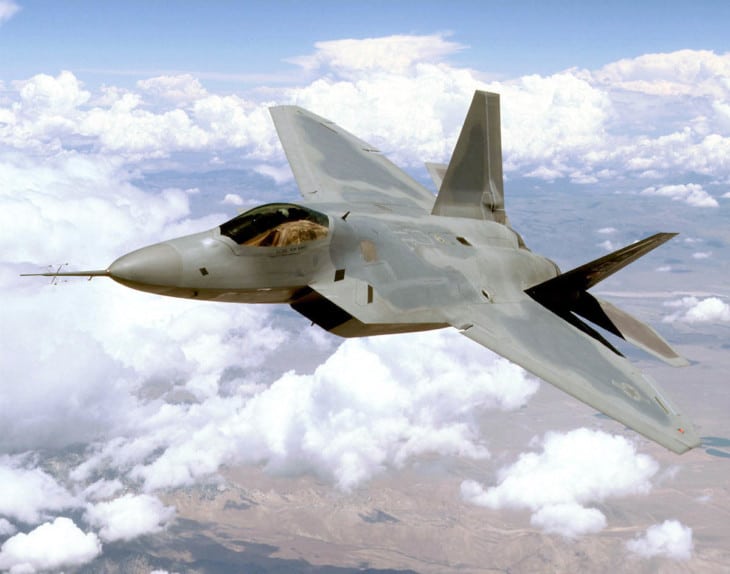
The F-22 Raptor is a twin-engine, stealth tactical fighter aircraft that entered service in December 2005. Developed for the United States Air Force, it was mainly designed as an air superiority fighter but can also act as an attack aircraft and an electronic-warfare aircraft with signal-intelligence capabilities. The first F-22 took its maiden flight on September 7, 1997.
The F-22 Raptor was designed to be the most refined fighter jet in the world. It is a fifth-generation air dominance fighter equipped with a combination of fourth-generation stealth technology, supermaneuverability, supercruise ability, unique sensor capability, integrated avionics, situational awareness, together with long-range air-to-air and air-to-ground weaponry that delivers the first-kill opportunity opposed its enemies.
The aircraft showcased its ability to supercruise, flying at a sustained supersonic speed of 1,220 mph. It has a typical range of over 1,600 nautical miles with 2 external fuel tanks and can fly up to 65,000 feet. The F-22 is one of the fastest fighter jets in the world.
8. Lockheed Martin A-4AR Fightinghawk

The A-4AR Fightinghawk is an upgraded A-4M Skyhawk fighter bomber built for the Argentine Air Force from 1996 to 1999. Lockheed Martin converted thirty-six US Marine Corps A-4M Skyhawks equipped with F-16 Fighting Falcon avionics. The aircraft was designated as the Fightinghawk and a prototype conducted its maiden flight in December 1999.
The upgrades featured more powerful entire airframe overhaul, Pratt and Whitney J52P-408A engines, Douglas Escapac 1-63 ejection seats and HGU-55/P flight helmets, Honeywell On-Board Oxygen Generation System, AN/APG-66V2 radar, hands-on throttle and stick control and a glass cockpit, head-up display, inertial navigation system, MIL-STD-1553B data bus, two AN/AYK-14 mission computers, radar warning receiver, onboard electronic countermeasures, and identification friend or foe.
The aircraft has a maximum speed of 671 mph and a typical range of 1,700 nautical miles. It can fly up to 42,250 feet and can climb at a rate of 8,440 feet per minute.
9. Lockheed Martin F-35 Lightning II
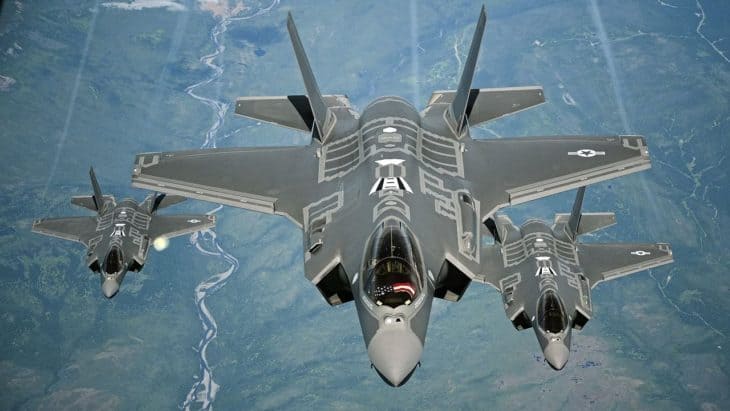
The stealth multirole combat aircraft F-35 Lightning II took to the skies for the first time on December 15, 2006. Designed for air dominance and attack missions, it is also equipped with electronic warfare and Intelligence, Surveillance, Target Acquisition, and Reconnaissance (ISTAR) capabilities. It is the second fifth-generation fighter in service with USAF and the first operational short take-off and vertical landing stealth aircraft.
The F-35 Lightning II is designed to conquer the most advanced threat systems in the present and the future, in the air and on the ground. The fifth-generation fighter features unparalleled stealth, extraordinary agility and maneuverability, integrated avionics, multi-spectral sensors, highly innovative computer systems that can connect to other systems for situational awareness, and radar detection avoidance capabilities.
The aircraft has a maximum speed of 806 mph at sea level and can fly up to 50,000 feet. It has a typical range of 1,500 nautical miles and a combat range of 760 nautical miles during interdiction missions.
Related Posts



